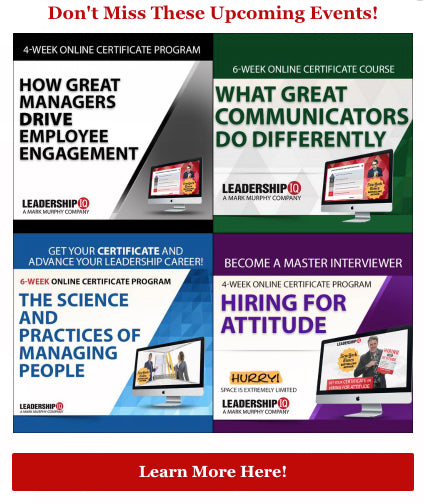You Actually Can Teach Employees How To Have A Great Attitude
This article originally appeared on Forbes by Mark Murphy, Founder of Leadership IQ
Teaching attitude is something that a lot of leaders give up on before they even try. They say “Pat just is the way he is. He’s a little cranky, and he’s a little sarcastic, but I can’t do much about that.” But when you look at great leaders, they do teach attitude, and so can you.
The first step is defining the attitudes you want to teach. Of course, you can’t just tell your employees “have a great attitude,” because they will have absolutely no idea what having a great attitude actually means. Should they act like start-up innovators who constantly experiment with new ideas? That sounds nice, but if I were managing an ICU in a hospital, I’d rather have my doctors and nurses implementing tried-and-true best practices.
Even going a little deeper is not enough. If you tell employees to be “accountable team players who give great customer service,” they’re still going to struggle. What does ‘great customer service’ actually mean? Be quick and efficient? Or move more slowly with more emotional-sensitivity?
Whatever attitudes you want your employees to exhibit, it’s going to take more than platitudes.
In the study “Fewer Than Half Of Employees Know If They’re Doing A Good Job,” I asked more than 30,000 employees if they know “whether my performance is where it should be.” And frighteningly, only 29% of employees say they “always” know whether their performance is where it should be. And a frightening 36% say they “Never” or “Rarely” know.
We can’t begin to teach employees how to exhibit a great attitude if they don’t know what a great attitude looks like and they don’t know whether they’re currently doing a good job exhibiting that attitude.
Use Word Pictures To Teach Attitude
Word Pictures is a training technique whereby you paint a clear behavioral verbal picture that tells employees exactly what the behaviors accompanying an attitude looks like broken down into three levels: “Needs Work,” “Good Work” and “Great Work.”
Bring some of your high performers together and ask for their feedback on these two questions:
- What are the behaviors that you exhibit that make you successful in your job?
- What are the behaviors you see others exhibit that irritate you or cause you problems or limit their success?
Focus on the key behaviors that matter most to your customers and which bring the most benefit to the organization. These are the behaviors that differentiate you from the competition. Work together to flesh out their responses into the three Word Pictures categories: 1: Needs Work, 2: Good Work and 3: Great Work.
Here’s an example of a Word Picture that I recently created with the managers of a midsize software company:
Needs Work: I often arrive to work and meetings late or leave early. I avoid extra work, and when working in a team I allow my coworkers to do most of the work. I am often found making personal calls and chatting at length with others about non-work related topics. My attendance record is poor: more than four days (as defined by the attendance policy) of unscheduled time off in any rolling six-month period. My boss has to tell me to take action. When I make mistakes, I blame others or make excuses. I appear overwhelmed by the demands of the organization’s high-paced environment.
Good Work: I stay on task in spite of distractions and interruptions. I carry my own fair share the workload. I don’t wait to be told to act and I often look for an opportunity to help move a project along. I display an obvious sense of urgency. I carry out commitments displaying a high-energy level. I respect the attendance policy and avoid missing work unnecessarily -- usually only two or three unscheduled absences during the year. I accept personal responsibility for quality and timeliness of work without making excuses or blaming others.
Great Work: I display enthusiasm for each new project. I take pride in my work and am often asked to assume leadership positions. If I am unsure about something, or uncover an unexpected problem, I take immediate action to remedy the situation and to bring it to the attention of others to avoid the problem in the future. I never miss work (no unscheduled absences) and I never leave a site/job with unfinished business. Not only do I accept personal responsibility for quality and timeliness of work without making excuses or blaming others, but when I see others making excuses or blaming, I redirect the conversation to focus on personal accountability.
When an employee reads those descriptions, it’s pretty clear what constitutes displaying a great attitude versus a bad attitude. If I make a mistake, offering an excuse or blaming someone else would constitute displaying a bad attitude. By contrast, if I accept personal responsibility without making excuses or blaming others, I’m displaying a good attitude. And if I want to exhibit a great attitude, then not only should I never blame others but I should also stop my colleagues from finger pointing.
You can create Word Pictures for just about anything, as long as the behaviors they describe are observable, gradable, verifiable, and explicit. I know this can seem painfully explicit. But by being so transparent about what does, and does not, constitute displaying a great attitude, I’m able to teach every employee exactly what they should, and shouldn’t, do.
Another wrinkle made possible by the design of Word Pictures is employee self-evaluation. Word Pictures helps develop employees’ critical self-awareness and, because of the behavioral specificity and learning design of Word Pictures, they immediately see where they should focus their personal improvement efforts.
Mark Murphy is the author of Truth At Work: The Science Of Delivering Tough Messages, Hiring For Attitude and Hundred Percenters.









